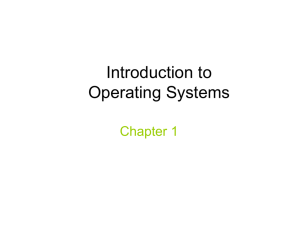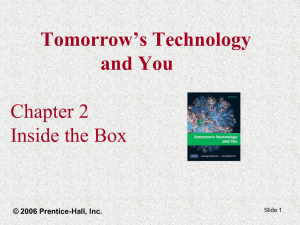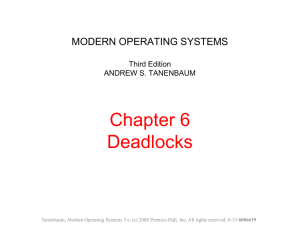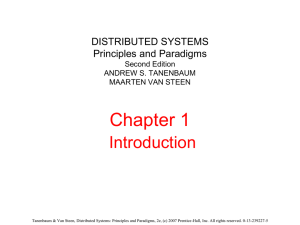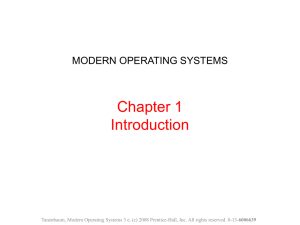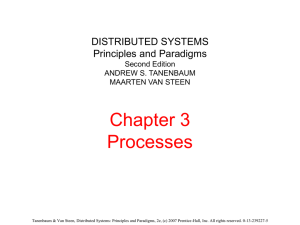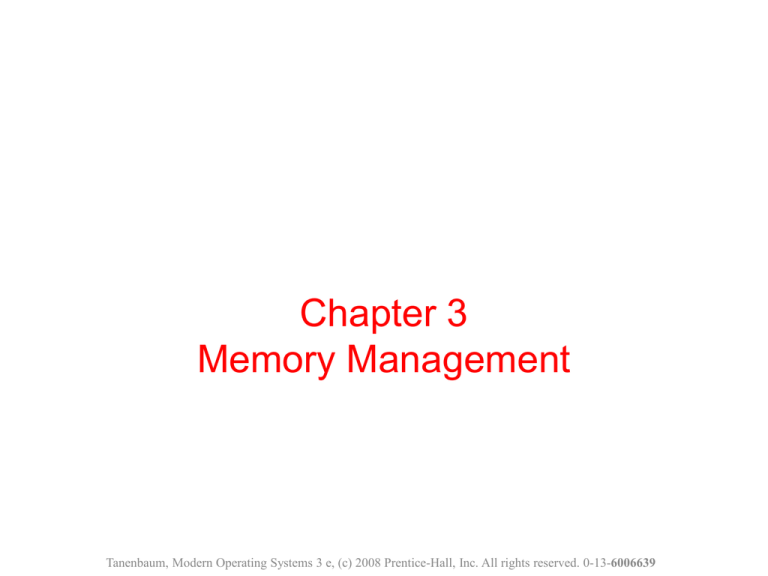
Chapter 3
Memory Management
Tanenbaum, Modern Operating Systems 3 e, (c) 2008 Prentice-Hall, Inc. All rights reserved. 0-13-6006639
Memory Management Basics
•
•
•
Don’t have infinite RAM
Do have a memory hierarchy•
Cache (fast)
•
Main(medium)
•
Disk(slow)
Memory manager has the job of using this hierarchy
to create an abstraction (illusion) of easily
accessible memory
Tanenbaum, Modern Operating Systems 3 e, (c) 2008 Prentice-Hall, Inc. All rights reserved. 0-13-6006639
One program at a time in memory
OS reads program in from disk and it is executed
Tanenbaum, Modern Operating Systems 3 e, (c) 2008 Prentice-Hall, Inc. All rights reserved. 0-13-6006639
One program at a time
•
•
•
•
Can only have one program in memory at a time.
Bug in user program can trash the OS (a and c)
Second on some embedded systems
Third on MS-DOS (early PCs) -part in ROM called
BIOS
Tanenbaum, Modern Operating Systems 3 e, (c) 2008 Prentice-Hall, Inc. All rights reserved. 0-13-6006639
Really want to run more than one program
•
•
Could swap new program into memory from
disk and send old one out to disk
Not really concurrent
Tanenbaum, Modern Operating Systems 3 e, (c) 2008 Prentice-Hall, Inc. All rights reserved. 0-13-6006639
IBM static relocation idea
•
•
•
IBM 360 -divide memory into 2 KB blocks, and
associate a 4 bit protection key with chunk. Keep
keys in registers.
Put key into PSW for program
Hardware prevents program from accessing block
with another protection key
Tanenbaum, Modern Operating Systems 3 e, (c) 2008 Prentice-Hall, Inc. All rights reserved. 0-13-6006639
Problem with relocation
JMP 28 in program (b) trashes ADD instruction in location 28
Program crashes
Tanenbaum, Modern Operating Systems 3 e, (c) 2008 Prentice-Hall, Inc. All rights reserved. 0-13-6006639
Static relocation
•
•
Problem is that both programs reference absolute physical
memory.
Static relocation- load first instruction of program at
address x, and add x to every subsequent address during
loading
•
This is too slow and
•
Not all addresses can be modified
•
Mov register 1,28 can’t be modified
Tanenbaum, Modern Operating Systems 3 e, (c) 2008 Prentice-Hall, Inc. All rights reserved. 0-13-6006639
Address Space
•
Create abstract memory space for program to exist in
•
Each program has its own set of addresses
•
The addresses are different for each program
•
Call it the address space of the program
Tanenbaum, Modern Operating Systems 3 e, (c) 2008 Prentice-Hall, Inc. All rights reserved. 0-13-6006639
Base and Limit Registers
•
•
•
•
•
•
A form of dynamic relocation
Base contains beginning address of program
Limit contains length of program
Program references memory, adds base address to
address generated by process. Checks to see if
address is larger then limit. If so, generates fault
Disadvantage-addition and comparison have to be
done on every instruction
Used in the CDC 6600 and the Intel 8088
Tanenbaum, Modern Operating Systems 3 e, (c) 2008 Prentice-Hall, Inc. All rights reserved. 0-13-6006639
Base and Limit Registers
Add 16384 to JMP 28. Hardware adds 16384 to 28 resulting
in JMP 16412
Tanenbaum, Modern Operating Systems 3 e, (c) 2008 Prentice-Hall, Inc. All rights reserved. 0-13-6006639
How to run more programs then fit in main
memory at once
•
•
Can’t keep all processes in main memory
•
Too many (hundreds)
•
Too big (e.g. 200 MB program)
Two approaches
•
Swap-bring program in and run it for awhile
•
Virtual memory-allow program to run even if only
part of it is in main memory
Tanenbaum, Modern Operating Systems 3 e, (c) 2008 Prentice-Hall, Inc. All rights reserved. 0-13-6006639
Swapping, a picture
Can compact holes by copying programs into holes
This takes too much time
Tanenbaum, Modern Operating Systems 3 e, (c) 2008 Prentice-Hall, Inc. All rights reserved. 0-13-6006639
Programs grow as they execute
•
•
•
•
Stack (return addresses and local variables)
Data segment (heap for variables which are
dynamically allocated and released)
Good idea to allocate extra memory for both
When program goes back to disk, don’t bring holes
along with it!!!
Tanenbaum, Modern Operating Systems 3 e, (c) 2008 Prentice-Hall, Inc. All rights reserved. 0-13-6006639
2 ways to allocate space for growth
(a) Just add extra space
(b) Stack grows downwards, data grows upwards
Tanenbaum, Modern Operating Systems 3 e, (c) 2008 Prentice-Hall, Inc. All rights reserved. 0-13-6006639
Managing Free Memory
•
Two techniques to keep track of free memory
•
Bitmaps
•
Linked lists
Tanenbaum, Modern Operating Systems 3 e, (c) 2008 Prentice-Hall, Inc. All rights reserved. 0-13-6006639
Bitmaps-the picture
(a)Picture of memory
(b)Each bit in bitmap corresponds to a unit of storage (e.g. bytes) in memory
(c) Linked list P: process H: hole
Tanenbaum, Modern Operating Systems 3 e, (c) 2008 Prentice-Hall, Inc. All rights reserved. 0-13-6006639
Bitmaps
•
•
The good-compact way to keep tract of memory
The bad-need to search memory for k consecutive
zeros to bring in a file k units long
•
Units can be bits or bytes or…….
Tanenbaum, Modern Operating Systems 3 e, (c) 2008 Prentice-Hall, Inc. All rights reserved. 0-13-6006639
Linked Lists-the picture
Four neighbor combinations for the terminating process, X.
Tanenbaum, Modern Operating Systems 3 e, (c) 2008 Prentice-Hall, Inc. All rights reserved. 0-13-6006639
Linked Lists
•
•
Might want to use doubly linked lists to merge holes
more easily
Algorithms to fill in the holes in memory
•
Next fit
•
Best fit
•
Worst fit
•
Quick fit
Tanenbaum, Modern Operating Systems 3 e, (c) 2008 Prentice-Hall, Inc. All rights reserved. 0-13-6006639
The fits
•
•
•
•
•
First fit-fast
Next fit-starts search wherever it is
•
Slightly worse
Best fit-smallest hole that fits
•
Slower, results in a bunch of small holes (i.e.
worse algorithm)
Worst fit-largest hole that fits
•
Not good (simulation results)
Quick fit- keep list of common sizes
•
Quick, but can’t find neighbors to merge with
Tanenbaum, Modern Operating Systems 3 e, (c) 2008 Prentice-Hall, Inc. All rights reserved. 0-13-6006639
The fits
•
Conclusion: the fits couldn’t out-smart the unknowable distribution of hole sizes
Tanenbaum, Modern Operating Systems 3 e, (c) 2008 Prentice-Hall, Inc. All rights reserved. 0-13-6006639
Virtual Memory-the history
•
•
•
Keep multiple parts of programs in memory
Swapping is too slow (100 Mbytes/sec disk transfer
rate=>10 sec to swap out a 1 Gbyte program)
Overlays-programmer breaks program into pieces
which are swapped in by overlay manager
•
Ancient idea-not really done
•
Too hard to do-programmer has to break up
program
Tanenbaum, Modern Operating Systems 3 e, (c) 2008 Prentice-Hall, Inc. All rights reserved. 0-13-6006639
Virtual Memory
•
•
•
•
•
Program’s address space is broken up into
fixed size pages
Pages are mapped to physical memory
If instruction refers to a page in memory, fine
Otherwise OS gets the page, reads it in, and
re-starts the instruction
While page is being read in, another
process gets the CPU
Tanenbaum, Modern Operating Systems 3 e, (c) 2008 Prentice-Hall, Inc. All rights reserved. 0-13-6006639
Memory Management Unit
•
Memory Management Unit generates
physical address from virtual address
provided by the program
Tanenbaum, Modern Operating Systems 3 e, (c) 2008 Prentice-Hall, Inc. All rights reserved. 0-13-6006639
Memory Management Unit
MMU maps virtual addresses to physical addresses and puts
them on memory bus
Tanenbaum, Modern Operating Systems 3 e, (c) 2008 Prentice-Hall, Inc. All rights reserved. 0-13-6006639
Pages and Page Frames
•
Virtual addresses divided into pages
• 512 bytes-64 KB range
• Transfer between RAM and disk is in
whole pages
• Example on next slide
Tanenbaum, Modern Operating Systems 3 e, (c) 2008 Prentice-Hall, Inc. All rights reserved. 0-13-6006639
Mapping of pages to page frames
16 bit addresses, 4 KB pages
32 KB physical memory,
16 virtual pages and 8 page frames
Tanenbaum, Modern Operating Systems 3 e, (c) 2008 Prentice-Hall, Inc. All rights reserved. 0-13-6006639
Page Fault Processing
•
Present/absent bit tells whether page is in
memory
• What happens If address is not in memory?
• Trap to the OS
• OS picks page to write to disk
• Brings page with (needed) address into
memory
• Re-starts instruction
Tanenbaum, Modern Operating Systems 3 e, (c) 2008 Prentice-Hall, Inc. All rights reserved. 0-13-6006639
Page Table
•
•
•
•
Virtual address={virtual page number, offset}
Virtual page number used to index into page table
to find page frame number
If present/absent bit is set to 1, attach page frame
number to the front of the offset, creating the
physical address
which is sent on the memory bus
Tanenbaum, Modern Operating Systems 3 e, (c) 2008 Prentice-Hall, Inc. All rights reserved. 0-13-6006639
MMU operation
Tanenbaum, Modern Operating Systems 3 e, (c) 2008 Prentice-Hall, Inc. All rights reserved. 0-13-6006639
Structure of Page Table Entry
•
•
•
•
Modified (dirty) bit: 1 means written to => have to write it to disk. 0
means don’t have to write to disk.
Referenced bit: 1 means it was either read or written. Used to pick
page to evict. Don’t want to get rid of page which is being used.
Present (1) / Absent (0) bit
Protection bits: r, w, r/w
.
Tanenbaum, Modern Operating Systems 3 e, (c) 2008 Prentice-Hall, Inc. All rights reserved. 0-13-6006639
Problems for paging
•
•
Virtual to physical mapping is done on every
memory reference => mapping must be fast
If the virtual address space is large, the page table
will be large. 32 bit addresses now and 64 bits
becoming more common
Tanenbaum, Modern Operating Systems 3 e, (c) 2008 Prentice-Hall, Inc. All rights reserved. 0-13-6006639
Stupid solutions
•
•
Bring page table for a process into MMU when it
is started up and store it in registers
Keep page table in main memory
Tanenbaum, Modern Operating Systems 3 e, (c) 2008 Prentice-Hall, Inc. All rights reserved. 0-13-6006639
Speed up Address Translation
•
•
Most programs access a small number of pages a
great deal
Add Translation Lookaside Buffer (TLB) to MMU
•
Stores frequently accessed frames
Tanenbaum, Modern Operating Systems 3 e, (c) 2008 Prentice-Hall, Inc. All rights reserved. 0-13-6006639
Translation Lookaside Buffers
Valid bit indicates whether page is in use or not
Tanenbaum, Modern Operating Systems 3 e, (c) 2008 Prentice-Hall, Inc. All rights reserved. 0-13-6006639
Translation Lookaside Buffer(TLB)
•
•
•
If address is in MMU, avoid page table
Uses parallel search to see if virtual page is in the
TLB
If not, does page table look up and evicts TLB entry,
replacing it with page just looked up
Tanenbaum, Modern Operating Systems 3 e, (c) 2008 Prentice-Hall, Inc. All rights reserved. 0-13-6006639
Software TLB management
•
•
•
•
•
Risc machines manage TLB in software
TLB fault processed by OS instead of by MMU
hardware
Results less hardware in MMU and OK
performance
Software can figure out which pages to pre-load
into TLB (eg. Load server after client request)
Keeps cache of frequently used pages
Tanenbaum, Modern Operating Systems 3 e, (c) 2008 Prentice-Hall, Inc. All rights reserved. 0-13-6006639
Multi-level page tables
•
•
•
Want to avoid keeping the entire page table in
memory because it is too big
Hierarchy of page tables does this
The hierarchy is a page table of page tables
Tanenbaum, Modern Operating Systems 3 e, (c) 2008 Prentice-Hall, Inc. All rights reserved. 0-13-6006639
Multilevel Page Tables
(a) A 32-bit address with two page table fields.
(b) Two-level page tables.
Tanenbaum, Modern Operating Systems 3 e, (c) 2008 Prentice-Hall, Inc. All rights reserved. 0-13-6006639
Use of multilevel page table
•
Top level of page table contains
•
Entry 0 points to pages for program text
•
Entry 1 points to pages for data
•
Entry 1023 points to pages for stack
Tanenbaum, Modern Operating Systems 3 e, (c) 2008 Prentice-Hall, Inc. All rights reserved. 0-13-6006639
Multi-level page table gets too big
•
•
•
•
•
Multi-level page table works for 32 bit memory
Doesn’t work for 64 bit memory
2*64 bytes and 4 KB pages => 2*52 entries in page
table
If each entry is 8 bytes=> 30 million Gbytes for
page table
Need a new solution
Tanenbaum, Modern Operating Systems 3 e, (c) 2008 Prentice-Hall, Inc. All rights reserved. 0-13-6006639
Inverted Page Table
•
•
•
Keep one entry per (real) page frame in the
“inverted” table
Entries keep track of (process,virtual page)
associated with page frame
Need to find frame associated with (n,p) for each
memory reference
Tanenbaum, Modern Operating Systems 3 e, (c) 2008 Prentice-Hall, Inc. All rights reserved. 0-13-6006639
Need to search inverted table efficiently
•
•
Search page frames on every memory reference
How to do this efficiently?
•
Keep heavily used frames in TLB
•
If miss, then can use and associative search to
find virtual page to frame mapping
•
Use a hash table
Tanenbaum, Modern Operating Systems 3 e, (c) 2008 Prentice-Hall, Inc. All rights reserved. 0-13-6006639
Inverted Page Tables-the picture
Tanenbaum, Modern Operating Systems 3 e, (c) 2008 Prentice-Hall, Inc. All rights reserved. 0-13-6006639
Page Replacement Algorithms
•
•
•
•
If new page is brought in, need to chose a page
to evict
Don’t want to evict heavily used pages
If page has been written to, need to copy it to
disk.
Otherwise, a good copy is on the disk=>can
write over it
Tanenbaum, Modern Operating Systems 3 e, (c) 2008 Prentice-Hall, Inc. All rights reserved. 0-13-6006639
Page Replacement Algorithms-the Laundry
List
•
•
•
•
•
•
•
•
Optimal page replacement algorithm
Not recently used page replacement
First-in, first-out page replacement
Second chance page replacement
Clock page replacement
Least recently used page replacement
Working set page replacement
WSClock page replacement
Tanenbaum, Modern Operating Systems 3 e, (c) 2008 Prentice-Hall, Inc. All rights reserved. 0-13-6006639
Optimal Page Replacement
•
•
•
Pick the one which will not used before the
longest time
Not possible unless know when pages will be
referenced (crystal ball)
Used as ideal reference algorithm
Tanenbaum, Modern Operating Systems 3 e, (c) 2008 Prentice-Hall, Inc. All rights reserved. 0-13-6006639
Not recently used
•
•
Use R and M bits
Periodically clear R bit
• Class 0: not referenced, not modified
• Class 1: not referenced, modified
• Class 2: referenced, not modified
• Class 3: referenced, modified
• Pick lowest priority page to evict
Tanenbaum, Modern Operating Systems 3 e, (c) 2008 Prentice-Hall, Inc. All rights reserved. 0-13-6006639
FIFO
•
•
•
•
Keep list ordered by time (latest to arrive at the
end of the list)
Evict the oldest, i.e. head of the line
Easy to implement
Oldest might be most heavily used! No
knowledge of use is included in FIFO
Tanenbaum, Modern Operating Systems 3 e, (c) 2008 Prentice-Hall, Inc. All rights reserved. 0-13-6006639
Second Chance Algorithm
•
•
•
Pages sorted in FIFO order by arrival time.
Examine R bit. If zero, evict. If one, put page at end of list and
R is set to zero.
If change value of R bit frequently, might still evict a heavily
used page
Tanenbaum, Modern Operating Systems 3 e, (c) 2008 Prentice-Hall, Inc. All rights reserved. 0-13-6006639
The Clock Page Replacement
Algorithm
Tanenbaum, Modern Operating Systems 3 e, (c) 2008 Prentice-Hall, Inc. All rights reserved. 0-13-6006639
Clock
•
•
•
Doesn’t use age as a reason to evict page
Faster-doesn’t manipulate a list
Doesn’t distinguish between how long pages
have not been referenced
Tanenbaum, Modern Operating Systems 3 e, (c) 2008 Prentice-Hall, Inc. All rights reserved. 0-13-6006639
LRU
•
•
Approximate LRU by assuming that recent
page usage approximates long term page
usage
Could associate counters with each page and
examine them but this is expensive
Tanenbaum, Modern Operating Systems 3 e, (c) 2008 Prentice-Hall, Inc. All rights reserved. 0-13-6006639
LRU-the hardware array
•
Associate counter with each page.
• At each reference increment counter.
•
Evict page with lowest counter
• Keep n x n array for n pages.Upon reference
page k, put 1’s in row k and 0’s in column k.
• Row with smallest binary value corresponds
to LRU page. Evict k!
• Easy hardware implementation
Tanenbaum, Modern Operating Systems 3 e, (c) 2008 Prentice-Hall, Inc. All rights reserved. 0-13-6006639
LRU-hardware
LRU using a matrix when pages are referenced in the order 0, 1,
2, 3, 2, 1, 0, 3, 2, 3.
Tanenbaum, Modern Operating Systems 3 e, (c) 2008 Prentice-Hall, Inc. All rights reserved. 0-13-6006639
LRU-software
•
•
Hardware uses space=> software
implementation
Make use of software counters
Tanenbaum, Modern Operating Systems 3 e, (c) 2008 Prentice-Hall, Inc. All rights reserved. 0-13-6006639
LRU in Software
Tanenbaum, Modern Operating Systems 3 e, (c) 2008 Prentice-Hall, Inc. All rights reserved. 0-13-6006639
LRU-software
•
•
•
•
•
“aging” algorithm
Keep a string of values of the R bits for each clock
tick (up to some limit)
After tick, shift bits right and add new R values on
the left
On page fault, evict page with lowest counter
Size of the counter determines the history
Tanenbaum, Modern Operating Systems 3 e, (c) 2008 Prentice-Hall, Inc. All rights reserved. 0-13-6006639
Working Set Model
•
•
•
Demand paging-bring a process into memory by
trying to execute first instruction and getting page
fault. Continue until all pages that process needs to
run are in memory (the working set)
Try to make sure that working set is in memory
before letting process run (pre-paging)
Thrashing-memory is too small to contain working
set, so page fault all of the time
Tanenbaum, Modern Operating Systems 3 e, (c) 2008 Prentice-Hall, Inc. All rights reserved. 0-13-6006639
Behavior of working set as a function of k
W(k,t) is number of pages at time t used by k most recent memory
references
Tanenbaum, Modern Operating Systems 3 e, (c) 2008 Prentice-Hall, Inc. All rights reserved. 0-13-6006639
How to implement working set model
•
•
•
When fault occurs can evict page not in
working set (if there is such a page)
Need to pick k
Could keep track of pages in memory at every
memory reference. Each k references results in
a working set.
•
Shift register implementation. Insert page number at
each reference.
•
Expensive
Tanenbaum, Modern Operating Systems 3 e, (c) 2008 Prentice-Hall, Inc. All rights reserved. 0-13-6006639
Use virtual time instead of number of
references (k)
•
Keep track of k last pages referenced during a
period t of execution (CPU) time
• Virtual time for a process is the amount of CPU
time used since it started
• Measure of how much work a process has
done
Tanenbaum, Modern Operating Systems 3 e, (c) 2008 Prentice-Hall, Inc. All rights reserved. 0-13-6006639
Working Set Page Replacement
(Check each clock tick)
Check each clock tick
Get rid of page with smallest time if all of the pages have R==0
Tanenbaum, Modern Operating Systems 3 e, (c) 2008 Prentice-Hall, Inc. All rights reserved. 0-13-6006639
Weakness with WS algorithm
•
•
Need to scan entire page table at each page
fault to find a victim
Use clock idea with working set algorithm
Tanenbaum, Modern Operating Systems 3 e, (c) 2008 Prentice-Hall, Inc. All rights reserved. 0-13-6006639
The WSClock Page Replacement Algorithm
Operation of the WSClock algorithm. (a) and (b) give an example
of what happens when R = 1.
Tanenbaum, Modern Operating Systems 3 e, (c) 2008 Prentice-Hall, Inc. All rights reserved. 0-13-6006639
The WSClock Page Replacement Algorithm (3)
Operation of the WSClock algorithm.
(c) and (d) give an example of R = 0.
Tanenbaum, Modern Operating Systems 3 e, (c) 2008 Prentice-Hall, Inc. All rights reserved. 0-13-6006639
The WSClock Page Replacement Algorithm
If the hand comes all the way around to its
starting point there are two cases to consider:
•
•
At least one write has been scheduled.
•
Hand keeps moving looking for clean page. Finds it
because a write eventually completes- evicts first
clean page hand comes to.
No writes have been scheduled.
•
Evict first (clean) page
Tanenbaum, Modern Operating Systems 3 e, (c) 2008 Prentice-Hall, Inc. All rights reserved. 0-13-6006639
Summary of Page Replacement Algorithms
.
Tanenbaum, Modern Operating Systems 3 e, (c) 2008 Prentice-Hall, Inc. All rights reserved. 0-13-6006639
Implementation Issues
•
Need to take into account a number of design issues
in order to get a working algorithm
Tanenbaum, Modern Operating Systems 3 e, (c) 2008 Prentice-Hall, Inc. All rights reserved. 0-13-6006639
Global versus Local choice of page
•
•
Global-take into account all of the processes
Local-take into account just the process which faulted
Tanenbaum, Modern Operating Systems 3 e, (c) 2008 Prentice-Hall, Inc. All rights reserved. 0-13-6006639
Global is better for the memory
•
•
•
•
Working sets grow and shrink over time
Processes have different sizes
Assign number of pages to each process proportional
to its size
Start with allocation based on size and use page fault
frequency (pff) to modify allocation size for each
process
Tanenbaum, Modern Operating Systems 3 e, (c) 2008 Prentice-Hall, Inc. All rights reserved. 0-13-6006639
PFF used to determine page allocation
Maintain upper (A) and lower (B) bounds for pff Try to keep
process in between bounds
Tanenbaum, Modern Operating Systems 3 e, (c) 2008 Prentice-Hall, Inc. All rights reserved. 0-13-6006639
Local Versus Global
•
•
•
Can use combination of algorithms
PFF is global component-determines page allocation
Replacement algorithm Is local component-determines
which page to kick out
Tanenbaum, Modern Operating Systems 3 e, (c) 2008 Prentice-Hall, Inc. All rights reserved. 0-13-6006639
Load Control
•
•
Why? Can still thrash because of too much demand
for memory.
Solution-swap process(es) out .
•
Ie. When desperate, get rid of a process
Tanenbaum, Modern Operating Systems 3 e, (c) 2008 Prentice-Hall, Inc. All rights reserved. 0-13-6006639
Page size
•
Overhead= s*e/p + p/2
[size of page entries + frag]
•
p is page size,
•
s is process size,
•
e is size of the page entry (in page table)
•
Differentiate, set to zero => p = √(2s*e)
•
s= 1 MB, e=8 bytes 4 KB is optimal
•
1 KB is typical
•
4-8 KB common
•
OK, this is a rough approach
Tanenbaum, Modern Operating Systems 3 e, (c) 2008 Prentice-Hall, Inc. All rights reserved. 0-13-6006639
Separate Instruction and Data Address
Spaces
Process address space too small => difficult to fit program in space
Split space into instructions (I) and data (D)
Old idea
Tanenbaum, Modern Operating Systems 3 e, (c) 2008 Prentice-Hall, Inc. All rights reserved. 0-13-6006639
Shared Pages
•
•
•
Different users can run same program (with different
data) at the same time. Better to share pages then to
have 2 copies!
Not all pages can be shared (data can’t be shared,
text can be shared)
If have D,I spaces can have process entry in process
table point to I and D pages
Tanenbaum, Modern Operating Systems 3 e, (c) 2008 Prentice-Hall, Inc. All rights reserved. 0-13-6006639
Shared Pages
Tanenbaum, Modern Operating Systems 3 e, (c) 2008 Prentice-Hall, Inc. All rights reserved. 0-13-6006639
More page sharing
•
•
Process can’t drop pages when it exits w/o being
certain that they not still in use
•
Use special data structure to track shared pages
Data sharing is painful (e.g. Unix fork, parent and child
share text and data) because of page writes
•
(Copy on write) solution is to map data to read only
pages. If write occurs, each process gets its own
page.
Tanenbaum, Modern Operating Systems 3 e, (c) 2008 Prentice-Hall, Inc. All rights reserved. 0-13-6006639
Shared Libraries
•
•
•
Large libraries (e.g. graphics) used by many process.
Too expensive to bind to each process which wants to
use them. Use shared libraries instead.
Unix linking: ld*.o –lc –lm . Files (and no others) not
present in .o are located in m or c libraries and
included in binaries.
Write object program to disk.
Tanenbaum, Modern Operating Systems 3 e, (c) 2008 Prentice-Hall, Inc. All rights reserved. 0-13-6006639
Shared Libraries
•
•
Linker uses a stub routine to call which binds to called
function AT RUN TIME.
•
Shared library is only loaded once (first time that a
function in it is referenced).
•
It is paged in
Need to use position independent code to avoid going
to the wrong address (next slide).
•
Idea: Compiler does not produce absolute
addresses when using shared libraries; only
relative addresses.
Tanenbaum, Modern Operating Systems 3 e, (c) 2008 Prentice-Hall, Inc. All rights reserved. 0-13-6006639
Shared Libraries
.
Tanenbaum, Modern Operating Systems 3 e, (c) 2008 Prentice-Hall, Inc. All rights reserved. 0-13-6006639
Memory Mapped Files
•
•
Process issues system call to map a file onto a
part of its virtual address space.
Can be used to used to communicate via
shared memory. Processes share same file.
Use it to read and write.
Tanenbaum, Modern Operating Systems 3 e, (c) 2008 Prentice-Hall, Inc. All rights reserved. 0-13-6006639
Cleaning Policy
•
•
•
Use a daemon to locate pages to evict before
you need them instead of looking for victims
when you need them
Daemon sleeps most of the time, periodically
awakens If there are “too few” frames, kicks out
frames
Make sure that they are clean before claiming
them
Tanenbaum, Modern Operating Systems 3 e, (c) 2008 Prentice-Hall, Inc. All rights reserved. 0-13-6006639
Virtual Memory Interface
•
Might want 2 programs to share physical
memory
• Easy way to implement shared memory
message passing
• Avoids memory copy approach to shared
memory
• Distributed shared memory-page fault handler
locates page in different machine, which sends
page to machine that needs it
Tanenbaum, Modern Operating Systems 3 e, (c) 2008 Prentice-Hall, Inc. All rights reserved. 0-13-6006639
Virtual Memory Interface
•
Might want 2 programs to share physical
memory
• Easy way to implement shared message
passing
• Avoids memory copies
• Distributed shared memory-page fault handler
locates page in different machine, which sends
page to machine that needs it
Tanenbaum, Modern Operating Systems 3 e, (c) 2008 Prentice-Hall, Inc. All rights reserved. 0-13-6006639
Implementation
•
OS has lots of involvement in paging when
process is: created,executes,page fault
happens,terminates
•
Look at several specific issues/problems
• Page fault handling
• Instruction backup
• Locking pages in memory
• Backing store-where to put pages on disk
Tanenbaum, Modern Operating Systems 3 e, (c) 2008 Prentice-Hall, Inc. All rights reserved. 0-13-6006639
Page Fault Handling (1)
•
•
•
•
The hardware traps to the kernel, saving the
program counter on the stack.
An assembly code routine is started to save the
general registers and other volatile information.
The operating system discovers that a page
fault has occurred, and tries to discover which
virtual page is needed.
Once the virtual address that caused the fault is
known, the system checks to see if this address
is valid and the protection consistent with the
access
Tanenbaum, Modern Operating Systems 3 e, (c) 2008 Prentice-Hall, Inc. All rights reserved. 0-13-6006639
Page Fault Handling (2)
•
•
•
If the page frame selected is dirty, the page is
scheduled for transfer to the disk, and a context
switch takes place.
When page frame is clean, operating system
looks up the disk address where the needed
page is, schedules a disk operation to bring it in.
When disk interrupt indicates page has arrived,
page tables updated to reflect position, frame
marked as being in normal state.
Tanenbaum, Modern Operating Systems 3 e, (c) 2008 Prentice-Hall, Inc. All rights reserved. 0-13-6006639
Page Fault Handling (3)
•
•
•
Faulting instruction backed up to state it had
when it began and program counter reset to
point to that instruction.
Faulting process scheduled, operating system
returns to the (assembly language) routine that
called it.
This routine reloads registers and other state
information and returns to user space to
continue execution, as if no fault had occurred.
Tanenbaum, Modern Operating Systems 3 e, (c) 2008 Prentice-Hall, Inc. All rights reserved. 0-13-6006639
Instruction Backup
•
•
•
Instruction causes fault => stopped part way
through, traps to OS for fault handling, OS
returns to instruction
Must re-start instruction
Easier said then done! For example
Tanenbaum, Modern Operating Systems 3 e, (c) 2008 Prentice-Hall, Inc. All rights reserved. 0-13-6006639
Instruction Backup (Motorola 680 x 2)
Where to re-start the instruction? PC depends on which part of the
instruction actually faulted. If it faults at 1002, how does OS
know that instruction starts at 1000?.
Tanenbaum, Modern Operating Systems 3 e, (c) 2008 Prentice-Hall, Inc. All rights reserved. 0-13-6006639
Instruction Backup
•
•
•
Worse yet: Auto-incrementing loads registers
either before or after instruction is executed. Do
it before and needs to be un-done. Do it
afterwards and must not do it.
Hardware solution to instruction backup-copy
current instruction to a register just before the
instruction is executed
Otherwise OS is deep in the swamp
Tanenbaum, Modern Operating Systems 3 e, (c) 2008 Prentice-Hall, Inc. All rights reserved. 0-13-6006639
Locking Pages in Memory
•
•
•
•
Process does I/O call, waits for data
Gets suspended while waiting, new process
read in, new process page faults
Global paging algorithm => incoming data writes
over new page
Solution: Lock pages engaged in I/O
Tanenbaum, Modern Operating Systems 3 e, (c) 2008 Prentice-Hall, Inc. All rights reserved. 0-13-6006639
Backing Store
•
Where is page put on disk when it is swapped
out? Two approaches
• Separate disk
• Use separate partition on disk which has no
file system on it
Tanenbaum, Modern Operating Systems 3 e, (c) 2008 Prentice-Hall, Inc. All rights reserved. 0-13-6006639
Backing Store
•
Static Partition-Allocate fixed partition to
process when it starts up
• Manage as list of free chunks. Assign big
enough chunk to hold process
• Starting address of partition kept in process
table. Page offset in virtual address space
corresponds to address on disk.
• Can assign different areas for data,text ,
stack as data and stack can grow
Tanenbaum, Modern Operating Systems 3 e, (c) 2008 Prentice-Hall, Inc. All rights reserved. 0-13-6006639
Backing Store-Dynamic
•
•
Dynamic approach-Don’t allocate disk space in
advance. Swap pages in and out as needed.
Need disk map in memory
Tanenbaum, Modern Operating Systems 3 e, (c) 2008 Prentice-Hall, Inc. All rights reserved. 0-13-6006639
Backing Store-the picture
Paging to a static swap area (a) and
Paging to dynamic area (b)
Tanenbaum, Modern Operating Systems 3 e, (c) 2008 Prentice-Hall, Inc. All rights reserved. 0-13-6006639
Separation of Policy and Mechanism (1)
Memory management system
•
•
•
A low-level MMU handler (machine dependent)
A page fault handler that is part of the kernel (machine
independent) Asks MMU to assign space for incoming
page in the process
An external pager running in user space which
contains the policy for page replacement and
asks/receives pages from disk
Tanenbaum, Modern Operating Systems 3 e, (c) 2008 Prentice-Hall, Inc. All rights reserved. 0-13-6006639
Separation of Policy and Mechanism (2)
How page fault happens-who does what.
Tanenbaum, Modern Operating Systems 3 e, (c) 2008 Prentice-Hall, Inc. All rights reserved. 0-13-6006639
The good vs the bad
•
•
The good: modular code => greater flexibility
The bad: Cross the user/kernel interface several times
in the course of a page fault
Tanenbaum, Modern Operating Systems 3 e, (c) 2008 Prentice-Hall, Inc. All rights reserved. 0-13-6006639
Segmentation
A compiler has many tables that are built up as
compilation proceeds, possibly including:
•
•
•
•
•
The source text being saved for the printed listing (on
batch systems).
The symbol table – the names and attributes of variables.
The table containing integer, floating-point constants
used.
The parse tree, the syntactic analysis of the program.
The stack used for procedure calls within the compiler.
Tanenbaum, Modern Operating Systems 3 e, (c) 2008 Prentice-Hall, Inc. All rights reserved. 0-13-6006639
One dimensional address space
. In a one-dimensional address space with growing tables, one
table may bump into another.
Tanenbaum, Modern Operating Systems 3 e, (c) 2008 Prentice-Hall, Inc. All rights reserved. 0-13-6006639
Segmentation
A segmented memory allows each table to grow or shrink
independently of the other tables.
Tanenbaum, Modern Operating Systems 3 e, (c) 2008 Prentice-Hall, Inc. All rights reserved. 0-13-6006639
Advantages of Segmentation
•
Simplifies handling of data structures which are
growing and shrinking
• Address space of segment n is of form (n,local
address) where (n,0) is starting address
• Can compile segments separately from other
segments
• Can put library in a segment and share it
• Can have different protections (r,w,x) for different
segments
Tanenbaum, Modern Operating Systems 3 e, (c) 2008 Prentice-Hall, Inc. All rights reserved. 0-13-6006639
Paging vs Segmentation
Comparison of paging and segmentation.
Tanenbaum, Modern Operating Systems 3 e, (c) 2008 Prentice-Hall, Inc. All rights reserved. 0-13-6006639
External fragging
(a)-(d) Development of checkerboarding. (e) Removal of the
checkerboarding by compaction.
Tanenbaum, Modern Operating Systems 3 e, (c) 2008 Prentice-Hall, Inc. All rights reserved. 0-13-6006639
Segmentation with Paging
•
•
•
•
•
Examine two systems
• Multics (the first)
• The Pentium
Honeywell 6000
2*18 segments, up to 65,538 (36 bit) words per
segment
Each program has a segment table (paged itself)
containing segment descriptors
Segment descriptor points to page table
Tanenbaum, Modern Operating Systems 3 e, (c) 2008 Prentice-Hall, Inc. All rights reserved. 0-13-6006639
Segmentation with Paging: MULTICS
The MULTICS virtual memory. (a) The descriptor
segment points to the page tables.
Tanenbaum, Modern Operating Systems 3 e, (c) 2008 Prentice-Hall, Inc. All rights reserved. 0-13-6006639
Segmentation with Paging
•
•
•
Segment descriptor says whether segment is in
main memory or not
If any part of segment is in memory, entire
segment is considered to be in memory
Virtual Address is (segment number, page
number, offset within page)
Tanenbaum, Modern Operating Systems 3 e, (c) 2008 Prentice-Hall, Inc. All rights reserved. 0-13-6006639
Segmentation with Paging: MULTICS
The MULTICS virtual memory. (b) A segment descriptor. The
numbers are the field lengths.
Tanenbaum, Modern Operating Systems 3 e, (c) 2008 Prentice-Hall, Inc. All rights reserved. 0-13-6006639
Segmentation with Paging: MULTICS
A 34-bit MULTICS virtual address.
Tanenbaum, Modern Operating Systems 3 e, (c) 2008 Prentice-Hall, Inc. All rights reserved. 0-13-6006639
Segmentation with Paging: MULTICS
When a memory reference occurs, the following
algorithm is carried out:
•
•
The segment number used to find segment descriptor.
Check is made to see if the segment’s page table is in
memory.
– If not, segment fault occurs.
– If there is a protection violation, a fault (trap) occurs.
Tanenbaum, Modern Operating Systems 3 e, (c) 2008 Prentice-Hall, Inc. All rights reserved. 0-13-6006639
Segmentation with Paging: MULTICS
•
Page table entry for the requested virtual page
examined.
– If the page itself is not in memory, a page fault is
triggered.
– If it is in memory, the main memory address of the
start of the page is extracted from the page table entry
•
•
The offset is added to the page origin to give the
main memory address where the word is located.
The read or store finally takes place.
Tanenbaum, Modern Operating Systems 3 e, (c) 2008 Prentice-Hall, Inc. All rights reserved. 0-13-6006639
Segmentation with Paging: MULTICS
Conversion of a two-part MULTICS address into a main memory
address.
Tanenbaum, Modern Operating Systems 3 e, (c) 2008 Prentice-Hall, Inc. All rights reserved. 0-13-6006639
MULTICS TLB
•
•
•
•
•
•
Too many references with algorithm
Use TLB (16 words)
Keep addresses of the 16 most recently
referenced pages in TLB
Addressing hardware checks to see if address is
in TLB
If so, gets address directly from TLB
If not, invoke algorithm (check descriptor…)
Tanenbaum, Modern Operating Systems 3 e, (c) 2008 Prentice-Hall, Inc. All rights reserved. 0-13-6006639
Segmentation with Paging: MULTICS (10)
Tanenbaum, Modern Operating Systems 3 e, (c) 2008 Prentice-Hall, Inc. All rights reserved. 0-13-6006639
Segmentation with Paging: The Pentium (1)
. A Pentium selector.
Tanenbaum, Modern Operating Systems 3 e, (c) 2008 Prentice-Hall, Inc. All rights reserved. 0-13-6006639
Segmentation with Paging: The Pentium (2)
Pentium code segment descriptor.
Data segments differ slightly.
Tanenbaum, Modern Operating Systems 3 e, (c) 2008 Prentice-Hall, Inc. All rights reserved. 0-13-6006639
Segmentation with Paging: The Pentium (3)
Conversion of a (selector, offset)
pair to a linear address.
Tanenbaum, Modern Operating Systems 3 e, (c) 2008 Prentice-Hall, Inc. All rights reserved. 0-13-6006639
Segmentation with Paging: The Pentium (4)
Mapping of a linear address onto a physical address.
Tanenbaum, Modern Operating Systems 3 e, (c) 2008 Prentice-Hall, Inc. All rights reserved. 0-13-6006639
Segmentation with Paging: The Pentium (5)
. Protection on the Pentium.
Tanenbaum, Modern Operating Systems 3 e, (c) 2008 Prentice-Hall, Inc. All rights reserved. 0-13-6006639

